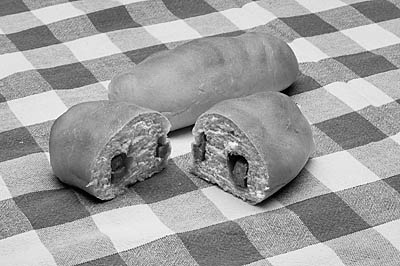
From Goldenseal
The magazine of West Virginia traditional life
Spring 2006 - Volume 32, Number 1 |
|
 |
|
The Pepperoni Roll: State Food of West Virginia By Colleen Anderson West Virginians enjoy and celebrate some native foods that many Americans don’t even know exist, much less eat — pawpaws and ramps come to mind. But the Mountain State is the bona fide birthplace of one beloved food item that has become much more familiar, in and out of the state, than these other homegrown delicacies — the pepperoni roll. The concept is culinary simplicity — bread dough wrapped around pepperoni. And no one seems to dispute that its inventor was Giuseppe (Joseph) Argiro [pronounced AR-juh-row], who came from Calabria, Italy, in 1920 to work in the Clarksburg-area coal mines. When he first traveled to America, Guiseppe Argiro left his pregnant wife, Teresa, behind. Within a few years, he had earned enough money to return to Italy and bring his wife and young son back with him to Clarksburg. Guiseppe soon left the mines and moved his growing family to Fairmont, where he started a soda pop bottling business. Then, in 1927, he opened People’s Bakery. The bakery was located on Robinson Street, and the family lived in the building behind it. The inventive Argiro got the idea for the pepperoni roll directly from his experiences in the mines. A common lunch for immigrant miners, according to Giuseppe’s younger son, Frank Argiro, consisted of “a slab of bread, a chunk of pepperoni, and a bucket of water.” At some point between 1927 and 1938 — nobody seems to know exactly when — Giuseppe began placing the spicy pepperoni within the bread, and the pepperoni roll was born. Combining the bread and pepperoni had a practical aspect: It turned a two-fisted eating experience into a convenient, one-handed operation. Evidently, Giuseppe Argiro knew he had devised a winner; he spent a good deal of time experimenting with the concept, changing bread dough recipes, pepperoni, and proportions until he was satisfied. He test-marketed the buns in beer halls where miners went to relax after their shifts. At first, Giuseppe sold his pepperoni rolls for 45 cents a dozen to the owners of the beer halls and to local grocers, who in turn sold them for five cents apiece. They were immediately popular, and their popularity has never lagged. You can read the rest of this article in this issue of Goldenseal, available in bookstores, libraries or direct from Goldenseal. |
|
Back to Bob Heffner's Pepperoni Roll Homepage